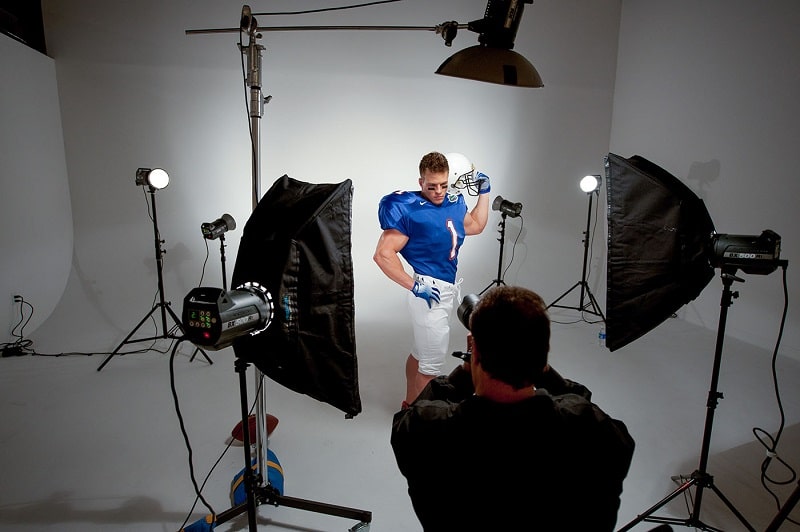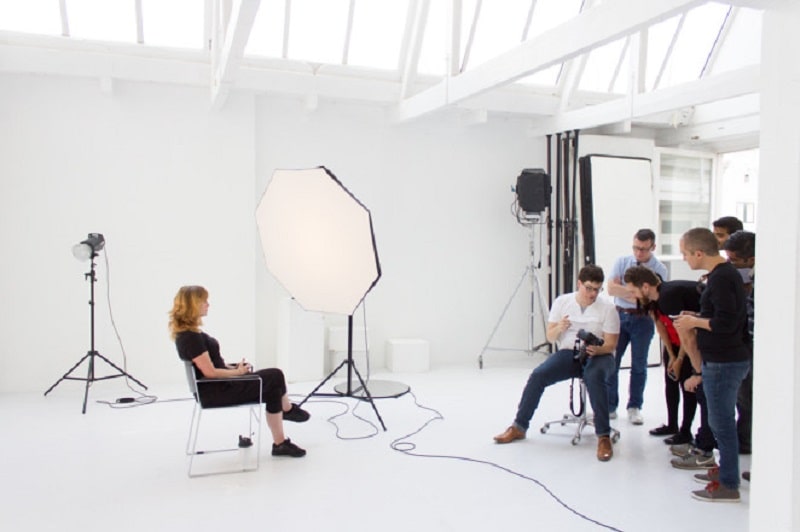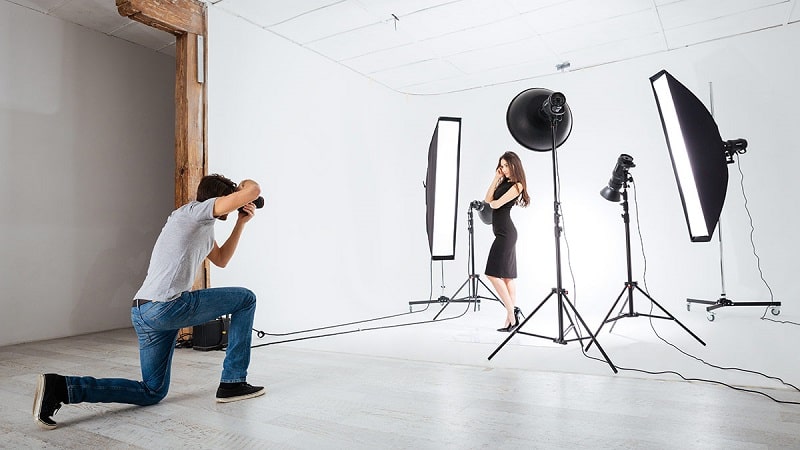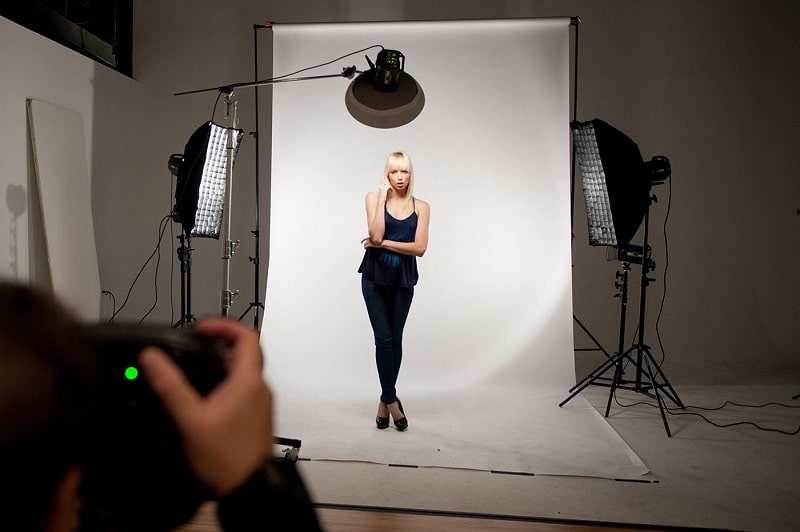If you are a photographer and you like to experiment with different photo shooting technique, good lighting is mandatory. Also, to get your desired portrait, the lighting plays a significant role in making your vision come into reality.
You can take help from the natural sunlight as a good source of lighting, but it gets challenging on the type of day when there is no sign of proper sunlight. If it rains or snows during the time of your photoshoot, dependency on the sun or another natural source of light will be a bad strategy for you.
Likewise, whether you are shooting marvelous portraits in your studio or living room, artificial lighting setup is highly essential. These lightings radiate a continuous stream of lights that focuses on your target area. Some of the light sources are floodlight, spotlight, and strobes (instant light flashes).
Contents

These lighting outfits come with a complete package. You will find it with different kinds of umbrellas, diffusers, reflectors, and a light stand. This complete package will play their part to provide you the best lighting.
However, the top advantage of using this kind of artificial lighting source is that you can check the lighting effects from the portrait, and if it doesn’t match with your choice, you can adjust the position in a different way to get your desired result.
Accordingly, the general purpose of the lighting is to provide the effects of natural lighting at any given time. If you let someone check the portrait, they won’t be able to tell the difference between the natural and artificial lighting from the beauty of the photo.
So, to make sure you get this successful result from your photoshoot, check out this article. Read it from start to end, and you will find out all the information that you need regarding the best lighting for portraits.

The Key Light is also known as the Main Light. It performs like the sun radiates its natural light onto the earth. You can position this in a longer height, and from there, you can adjust it directly to your target area, approximately 45 degrees. To get traditional glamour lighting, you can position this to the right of the subject (target area).
If you are interested in making the face of your subject look slimmer or thinner, lower the height and move the lighting towards the right again. In this way, your lighting will be much more directional and focused.
One thing you should keep in mind is that you should always position the key light within or above the height of the subject’s head. If you place it below the head, unfortunately, you will end up getting a portrait with unnatural effect.

Soft Light is also known as Diffuse Light. You can control this very easily without any hesitation. Usually, professional photographers prefer to use parabolic reflectors onto their light sources to create noticeable effects. With the help of Soft light and diffusion discs, you can create the same effect. Not only that, you can use the umbrella as a good alternative.
Overall, it shows that using Soft light is a very process because you can place it very easily and smoothly without giving a double check.
Nowadays, various professionals are shifting towards using this light due to multiple benefits. This light is a must for any studio portraits, and the experienced photo shooters highly recommend it.
As a photographer, gain as many experiences as necessary by using this light because it will surely help you in the long run. There might come a time where you have to use stronger light sources, and with the experiences of using Soft light in your arsenal, nothing will become a challenge for you.

This light is weaker than the Key Light, and it is mainly used as an extra light. If you place the Key light on one side, you have to set this light onto the other side. This other side is the shadow side that is targeted at your subject, and it helps to provide a good outline of the overall subject.
In many situations, the Fill Light is adjusted to radiate about half the level of the lights emitted by the Key Light. To get a traditional glamour portrait, the Fill Light you should place under the Key Light, and both should be targeted directly onto the subject. You can also use a reflector on the opposite end of the subject as a substitute for the shadows.
The Background Light is a very flexible one, and it is very famous worldwide. Professional photographers prefer to use it in all cases. If you are planning to use it, you should know some basic guidelines. You have to place it low and behind the subject so that it can generate a semi-circular light pattern onto the background.
This pattern will make the center lighter than normal, and the edges of the frame will look darker. This technique is very efficient if you have a smooth background. The color of the background should be uniform to get a top-notch portrait.
The Hair Light is also known as the Kicker. It is usually placed above the head of the subject to generate highlights onto the hair. The purpose of using this light is to show details on the hair and to provide a realistic view. Focusing on the subject’s face is not the task of this light.
If you are up for this kind of portrait, you have to place this light in the opposite direction from the Key Light.
Below, you will find some of the lighting patterns that every photographer should know to provide a perfect portrait lighting setups.
This lighting pattern is also known as Glamour Lighting. You have to use the Key and fill light for this setup. Adjust the Key light in a longer height and target it straight towards the front face of the subject.
Take the Fill light and place it gently below the Key light. Use a reflector and put it in the opposite direction of both the lights, mainly closer to the subject to provide a good substitute for the shadows.
Optional technique: Adjust the Hair light above the subject, focusing on the hair and a Background light positioned in a lower angle targeting the background. If everything goes according to the information, you will see a beautiful butterfly shadow formed below the subject’s nose.
You need a Key Light, Fill Light, and Hair Light for this purpose. Take the Key Light and adjust it at an angle of 90 degrees. Position it slightly onto the left side of the subject’s face. Use the Fill light and place it carefully onto the opposite side of the camera at a distance from the Key Light.
The placement of this light should be closer to the distance between the camera and the subject. If you are interested in taking a portrait that will show the side face and shoulder of the subject, you can use the Hair light or Kicker in this case.
Split lighting got its name due to a particular situation. It happens when the Key Light radiates only half the face, and it generates a noticeable effect when no Fill Lights are used.
You should use the Key Light and target it on one side, mainly on the left of the subject’s face. The angular position should be around 90 degrees but you have to make sure that you have positioned the light slightly under the subject.
However, if you are planning to minimize the facial defects, use the Fill Light and position it onto the other side closer to the camera. You can use Hair Light and background Light also.
Just place the former one above the subject and the latter one behind it. Target the latter onto straight at the background. You will see that half of the face is brighter and the other half is darker.
Loop lighting can be made if you are able to successfully create a small shadow of the subject’s nose onto the cheek. To create this kind of lighting, you have to adjust the light sources slightly higher than the eye level of the subject. The angular position should be about 30 to 45 degrees from the camera.
Besides, some important facts that you should remember are that the shadow of the nose and cheek will not touch if you are up for creating loop lighting. Don’t position the light source too high, or else it will create some uneven and odd shadows and will ruin your portrait. Always keep the shadow in a smaller form and point it slightly downward.
There you have it, a collection of best lighting for portraits. As you have seen, each of the lightings you can use for different purposes. If you prefer to take pictures of things other than humans, consider using Soft Lights as it will not focus on the skin and other details.
Experiment with all the lighting to get your desirable portrait.
Best of luck!
 |
 |
 |
 |
Check These Out